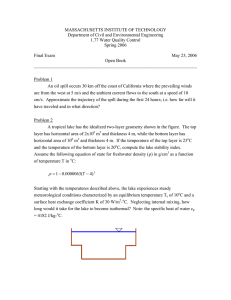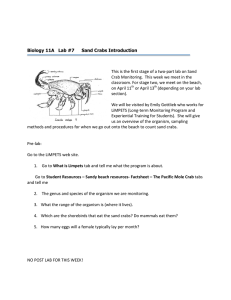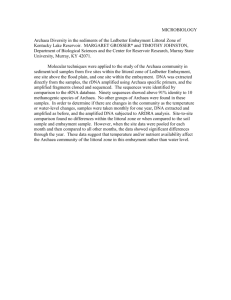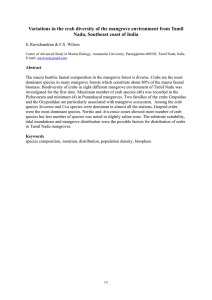HABITAT USE AND POPULATION DYNAMICS OF BLUE CRABS, CALLINECTES SAPIDUS,
advertisement
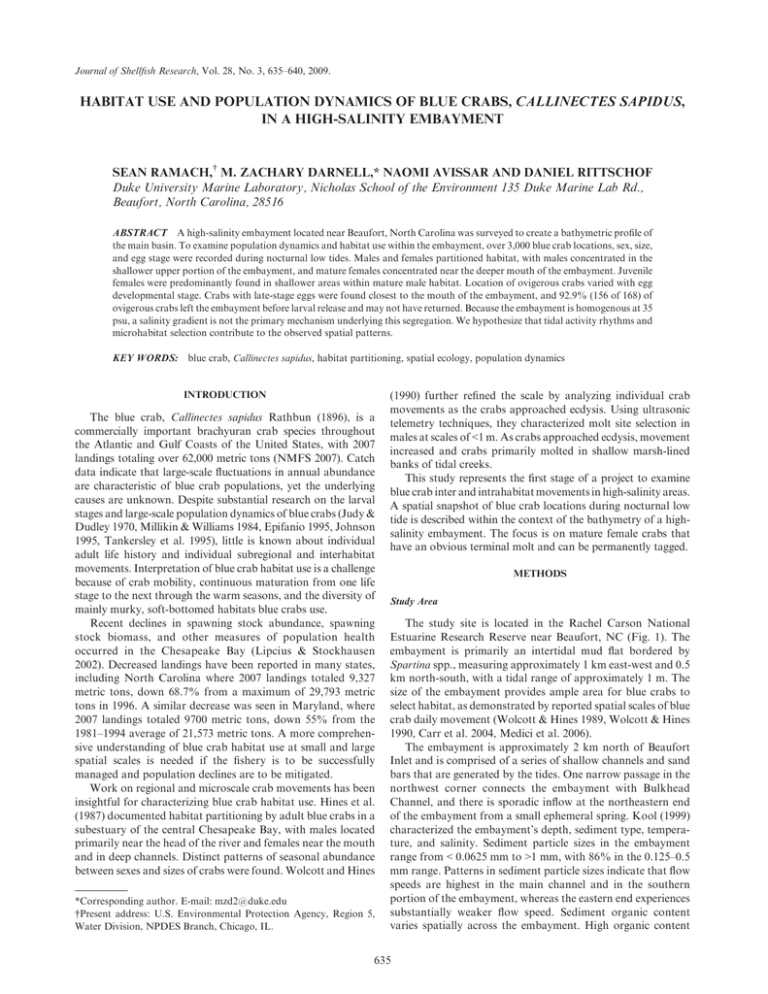
Journal of Shellfish Research, Vol. 28, No. 3, 635–640, 2009. HABITAT USE AND POPULATION DYNAMICS OF BLUE CRABS, CALLINECTES SAPIDUS, IN A HIGH-SALINITY EMBAYMENT SEAN RAMACH,† M. ZACHARY DARNELL,* NAOMI AVISSAR AND DANIEL RITTSCHOF Duke University Marine Laboratory, Nicholas School of the Environment 135 Duke Marine Lab Rd., Beaufort, North Carolina, 28516 ABSTRACT A high-salinity embayment located near Beaufort, North Carolina was surveyed to create a bathymetric profile of the main basin. To examine population dynamics and habitat use within the embayment, over 3,000 blue crab locations, sex, size, and egg stage were recorded during nocturnal low tides. Males and females partitioned habitat, with males concentrated in the shallower upper portion of the embayment, and mature females concentrated near the deeper mouth of the embayment. Juvenile females were predominantly found in shallower areas within mature male habitat. Location of ovigerous crabs varied with egg developmental stage. Crabs with late-stage eggs were found closest to the mouth of the embayment, and 92.9% (156 of 168) of ovigerous crabs left the embayment before larval release and may not have returned. Because the embayment is homogenous at 35 psu, a salinity gradient is not the primary mechanism underlying this segregation. We hypothesize that tidal activity rhythms and microhabitat selection contribute to the observed spatial patterns. KEY WORDS: blue crab, Callinectes sapidus, habitat partitioning, spatial ecology, population dynamics INTRODUCTION The blue crab, Callinectes sapidus Rathbun (1896), is a commercially important brachyuran crab species throughout the Atlantic and Gulf Coasts of the United States, with 2007 landings totaling over 62,000 metric tons (NMFS 2007). Catch data indicate that large-scale fluctuations in annual abundance are characteristic of blue crab populations, yet the underlying causes are unknown. Despite substantial research on the larval stages and large-scale population dynamics of blue crabs (Judy & Dudley 1970, Millikin & Williams 1984, Epifanio 1995, Johnson 1995, Tankersley et al. 1995), little is known about individual adult life history and individual subregional and interhabitat movements. Interpretation of blue crab habitat use is a challenge because of crab mobility, continuous maturation from one life stage to the next through the warm seasons, and the diversity of mainly murky, soft-bottomed habitats blue crabs use. Recent declines in spawning stock abundance, spawning stock biomass, and other measures of population health occurred in the Chesapeake Bay (Lipcius & Stockhausen 2002). Decreased landings have been reported in many states, including North Carolina where 2007 landings totaled 9,327 metric tons, down 68.7% from a maximum of 29,793 metric tons in 1996. A similar decrease was seen in Maryland, where 2007 landings totaled 9700 metric tons, down 55% from the 1981–1994 average of 21,573 metric tons. A more comprehensive understanding of blue crab habitat use at small and large spatial scales is needed if the fishery is to be successfully managed and population declines are to be mitigated. Work on regional and microscale crab movements has been insightful for characterizing blue crab habitat use. Hines et al. (1987) documented habitat partitioning by adult blue crabs in a subestuary of the central Chesapeake Bay, with males located primarily near the head of the river and females near the mouth and in deep channels. Distinct patterns of seasonal abundance between sexes and sizes of crabs were found. Wolcott and Hines *Corresponding author. E-mail: mzd2@duke.edu †Present address: U.S. Environmental Protection Agency, Region 5, Water Division, NPDES Branch, Chicago, IL. (1990) further refined the scale by analyzing individual crab movements as the crabs approached ecdysis. Using ultrasonic telemetry techniques, they characterized molt site selection in males at scales of <1 m. As crabs approached ecdysis, movement increased and crabs primarily molted in shallow marsh-lined banks of tidal creeks. This study represents the first stage of a project to examine blue crab inter and intrahabitat movements in high-salinity areas. A spatial snapshot of blue crab locations during nocturnal low tide is described within the context of the bathymetry of a highsalinity embayment. The focus is on mature female crabs that have an obvious terminal molt and can be permanently tagged. METHODS Study Area The study site is located in the Rachel Carson National Estuarine Research Reserve near Beaufort, NC (Fig. 1). The embayment is primarily an intertidal mud flat bordered by Spartina spp., measuring approximately 1 km east-west and 0.5 km north-south, with a tidal range of approximately 1 m. The size of the embayment provides ample area for blue crabs to select habitat, as demonstrated by reported spatial scales of blue crab daily movement (Wolcott & Hines 1989, Wolcott & Hines 1990, Carr et al. 2004, Medici et al. 2006). The embayment is approximately 2 km north of Beaufort Inlet and is comprised of a series of shallow channels and sand bars that are generated by the tides. One narrow passage in the northwest corner connects the embayment with Bulkhead Channel, and there is sporadic inflow at the northeastern end of the embayment from a small ephemeral spring. Kool (1999) characterized the embayment’s depth, sediment type, temperature, and salinity. Sediment particle sizes in the embayment range from < 0.0625 mm to >1 mm, with 86% in the 0.125–0.5 mm range. Patterns in sediment particle sizes indicate that flow speeds are highest in the main channel and in the southern portion of the embayment, whereas the eastern end experiences substantially weaker flow speed. Sediment organic content varies spatially across the embayment. High organic content 635 636 RAMACH ET AL. The embayment was surveyed during the summer of 2000 using a survey level (24X bulls-eye self-leveling) and a rod demarcated in 3.2 mm increments. All measurements were referenced to one local benchmark, which was in turn related to the 1927 datum from a NOS tidal benchmark located on the Pivers Island sea wall at the Duke University Marine Laboratory, approximately 0.5 km north of the embayment. This enabled calculation of relative depth below the ambient water level, at any time, for any point within the embayment using tidal levels obtained from the NOAA sampling station on Pivers Island. A bathymetric map was produced using ARC-INFO 8.0 (ESRI 1999). A continuous bathymetric profile (resolution ¼ 1 m) was created from the 10 m point grid using distanceweighted averages. The semivariograms for each possible equation indicated that the best method for this interpolation was the universal 1 method, which uses linear equations combined with a correction for spatial drift stemming from the local trend in change of depth. Figure 1. Area of study site located in the Rachel Carson National Estuarine Research Reserve near Beaufort, NC. is found in the western and northern portions of the embayment, with the exception of the main channel. Sediment organic content is lowest in the southeastern portion of the embayment. Salinity in the embayment is typically homogenous at 35 psu, though it ranges from 38 psu to 24 psu during times of high runoff after heavy rains associated with large tropical and subtropical storms (Kool 1999). Spring low tides in the late fall and winter drain the embayment, except for the main channels that remain several centimeters to just over a meter deep. Spring high tides overwash the sand spit to the south that separates the embayment from Back Sound. Water temperature ranges from 14°C to 31°C during the blue crab’s active season. Bathymetric Surveys The 1999 hurricane season dramatically changed the bathymetry of the embayment, necessitating a new survey of the embayment for the current study. The study area within the embayment is approximately 350 m by 600 m. For surveying, a study area was established with corners at: (1) 34°42.740#N, 76°40.485#W, (2) 34°42.529#N, 76°40.485#W, (3) 34°42.529# N, 76° 40.092# W, and (4) 34°42.740#N, 76°40.092#W (Fig. 1). A 10m grid (after Kool 1999) was determined to be the maximum distance that accurately captured the smaller topographic features of the embayment, while minimizing the number of data points. This grid was established with grid lines running directly north-south and east-west. The position of each point in the grid was established over the period of one week using a GPS receiver (Garmin model 12 XL) and differential receiver (Garmin model 21), and marked with surveying flags. The differential correction signal originated at the Fort Macon Coast Guard Station, <2 km from the embayment with a clear line of sight. Data points were measured in degrees decimal minutes in the NAD83 datum. To ensure an accurate position was obtained, multiple coordinate fixes were taken at each point until the same pair of coordinates was obtained at least three times. The east and north boundaries were then measured to verify the accuracy of GPS intervals. Errors in latitude varied from 0.005–0.007 min and longitudinal errors ranged from 0.007–0.009 min. Crab Data Collection Crabs were captured manually at night using a dip net from approximately 1 h before low tide to 1 h after low tide. At low tide, maximum water depth is roughly one meter, and the entire study area is accessible on foot. Crabs were observed using a waterproof dive light (Underwater Kinetics D4) attached to a stick and held near the sediment. Capture efficiency using this method is near 100% for all crab stages large enough to be retained in the net (;75 mm). Sampling was limited to the time of nocturnal low tides because it is not possible to view the crabs from above during daylight hours except in the shallowest areas and because water depths at other tidal phases preclude accessing the study area on foot. Despite these limitations, this collection method has high resolution and similar efficiencies at varying depths and habitats as compared with seining, potting, or trawling. Collection teams consisted of 3–8 individuals, and effort varied according to the number of collectors and weather conditions. Data were collected on five consecutive days approximately biweekly for a period of six months during each low tide that occurred between sunset and midnight. After capture, the location of each crab was recorded using a GPS (as mentioned earlier). Differential units or corrections were not used because the error of the GPS units (2–4 m) was low compared with the mobility of the crabs. Each crab was measured for carapace width between the tips of the large lateral spines and sexed by visual inspection of the abdomen. Ovigerous females were visually checked for egg color as a proxy for stage of embryo development which is usually synchronous within a clutch. Egg color changes from yellow to orange to brown and finally black as the eggs mature. Most of the mature females (887 out of 1,226) and some large males (223 out of 1,118) were then fitted with an individually-numbered over-the-back tag, attached around the lateral spines with 18 gauge plastic-coated copper wire. Juvenile females were not tagged, as the tag would be lost at the molt. Recaptured marked crabs were assessed in the same way, though carapace width was not remeasured. Data Analysis Crab capture locations were overlaid on the bathymetric map of the embayment. By sampling the bathymetric map with the capture locations, depth was determined for each crab. Data BLUE CRAB SPATIAL ECOLOGY were analyzed for variance in spatial location between sexes and egg stages. Because none of the data were normally distributed, Kruskal-Wallis one-way ANOVA on ranks was used for all analyses. Dunn’s multiple comparison tests were used when statistical significance (P < 0.05) was indicated by ANOVA. Residence times were calculated for all crabs that were recaptured at least once as the time from initial tagging to final recapture. Recapture rates were calculated as the percentage of tagged crabs that were recaptured at least once. RESULTS Bathymetric Survey Figure 2(a) presents the bathymetric survey produced for the embayment. All depths are relative to mean lower low water (MLLW). Bathymetry in the embayment ranged from 162 cm above MLLW to 107 cm below MLLW. Maximum depths were in the main channel in the northwestern corner of the embayment. During the summer neap tides, most of the channels were a little over 1 m deep during the sampling interval. Population Demographics Over the course of the study period, 1,110 individual crabs were marked, and a total of 3,173 crab locations were recorded. The sex ratio of mature crabs in the embayment was skewed 637 towards females in the spring and early summer and approached 1:1 in the fall (Fig. 3, Fig. 4). Ovigerous females peaked from June through August, then tapered off in the fall months. Nonovigerous females showed a bimodal distribution, with peaks in July and October. Juvenile females showed a single peak in August. Male crabs showed a similar peak in August and another peak toward the end of the study period as the number of active females in the embayment declined. Location of Male and Female Crabs Throughout the study, crab location remained fairly consistent with respect to sex. Males and juvenile females were primarily found further from the mouth of the embayment than were mature female crabs (Fig. 2b to e). Kruskal-Wallis ANOVA on ranks indicated significant (P < 0.05) differences in both latitude and longitude between sexes. Dunn’s multiple comparison test indicated significant differences in both latitude and longitude between mature females and males and in latitude and longitude between mature females and immature females. Males and juvenile females were found at similar latitudes and longitudes. Depth was similarly analyzed with a Kruskal-Wallis ANOVA on ranks and significant differences were detected between sexes (P < 0.001). Males were found significantly shallower than mature females, and juvenile females were significantly shallower than males (Dunn’s multiple comparison test, P < 0.05). Figure 2. (a) Bathymetric map of the surveyed area. Depths reported are relative to MLLW. Capture locations for blue crabs plotted on the bathymetric map for (b) all crabs, (c) male crabs, (d) juvenile female crabs, (e) mature female crabs, and (f) ovigerous female crabs, colored according to egg stage. Note that the scale bar applies to all panels. 638 RAMACH ET AL. than were females with early-stage (orange) eggs (Fig. 2f). Females with late-stage eggs were found at significantly (P < 0.001, Dunn’s multiple comparison test) different latitudes and longitudes than females with early-stage eggs, and females with late-stage eggs were also found at significantly shallower depths than females with early-stage eggs (P < 0.001, Dunn’s multiple comparison test). Ovigerous crabs generally left the embayment before releasing larvae and were usually not recaptured. Of 168 ovigerous crabs marked in the embayment, 12 (7.1%) were subsequently recaptured after larval release. Of these 12 crabs, 6 crabs were captured in the embayment without a clutch of eggs within a week of release. DISCUSSION Figure 3. Composition of the blue crab population from July to November 2000. Note that the y-axis is cumulative. Tagged male and mature female crabs were often recaptured within the embayment. Of 223 male crabs tagged, 71 (31.8%) were recaptured at least once. Multiple recaptures were also common, with 15 males and 87 females recaptured more than once within the embayment. Females were recaptured up to 4 times after initial tagging. Males were recaptured up to 3 times after initial tagging. Of the 887 mature female crabs tagged, 257 were recaptured, for a recapture rate of 29.0%. Median residence time for female crabs was significantly higher than for male crabs (Mann-Whitney Rank Sum Test, P ¼ 0.013). Female residence times ranged from 1–89 d (mean ¼ 9.85 ± 0.7 d) and male residence times ranged from 1–92 d (mean ¼ 7.92 ± 1.6 d). Male and female crabs were often recaptured after several weeks of absence, indicating that crabs did not remain strictly within the embayment. Location and Egg Stage Ovigerous female habitat use varied by developmental stage of the eggs. Females with late-stage (black) eggs were primarily located closer to the northwestern mouth of the embayment Figure 4. Number of male and various stages of female blue crabs collected from July to November 2000. To reduce the effect of unequal effort, data are plotted in approximately monthly intervals (corresponding to two sampling periods). Spatial analysis indicates that the embayment is habitat for blue crabs in two regards: (1) as part of the home range of a resident population and (2) as a transitory habitat for migrating individuals. The baseline data established in this study will provide critical comparisons for following larger scale regional studies of blue crab habitat use, movements, and population dynamics in high-salinity waters. Some time after mating, female crabs undertake a spawning migration to high-salinity water using ebb-tide transport (ETT) (Tankersley et al. 1998, Carr et al. 2004). In strongly tidal systems, including the Beaufort Inlet drainage, the basis of ETT is a circatidal rhythm in vertical swimming, with maximum swimming occurring during ebb-tides (Forward et al. 2003). During this migration, multiple clutches of eggs are produced (Dickinson et al. 2006) and migratory behavior continues through successive clutches (Hench et al. 2004, Forward et al. 2005). The spike of females seen at the beginning of the study period (Fig. 3, 4) was likely the movement of spawning crabs into the embayment, which they use as a foraging habitat while extruding and incubating a clutch of eggs. The use of microhabitat by ovigerous crabs was related to egg stage (Fig. 2f). Females with late-stage eggs were found closer to the embayment’s entrance than females with early-stage eggs. This pattern would be expected if females migrate into the embayment around the time of oviposition and forage in the shallower areas until near the time of larval release, when they migrate using ebb-tide transport. Ovigerous crabs that entered the embayment were transitory, staying usually until the time of larval release. Because females migrate seaward on falling tides (Hench et al. 2004), most females did not reappear in the embayment after larval release. Ovigerous females tagged in the embayment were recaptured by commercial and recreational crabbers as far as 25 miles away (Rittschof, unpublished data). Based on estimates of migration rates (Carr et al. 2004, Medici et al. 2006), these females may have migrated into the coastal ocean within one tidal cycle after leaving the embayment. By late fall, the movement of ovigerous crabs through the embayment slowed and the sex ratio was relatively equal. As the number of spawning females began to drop, juvenile females continued to molt to maturity. The spikes in frequency of nonovigerous females in July and October follow observed trends in molting to maturity and mating in the embayment, with peaks during May/June and September (Darnell, pers. obs.). These may have been females that recently molted to maturity, but had not yet produced their first clutch of eggs. The male population appeared to peak twice (Fig. 3, 4). An BLUE CRAB SPATIAL ECOLOGY August peak may have been from male crabs moving into the embayment and associated shallows for molting. A second peak, in October, may have been from males in the embayment molting to a larger size in preparation for mating during the peak in female molting the following spring. These males may have moved into the embayment from elsewhere to molt, or may have reached the minimum capture size after molting, thus causing a peak in number of males captured. High recapture rates and long residence times indicate that the embayment serves as part of a home range for a resident population of blue crabs. Crabs were often tagged in the embayment, only to be recaptured in the embayment 1–3 mo later, having been at large in the interim. Because of the sampling scheme, it can reasonably be assumed that a high percentage of crabs in the embayment were captured during every 5-day sampling block. Thus, the nominal home range for these crabs is larger than the embayment itself. Mature females remaining in the embayment for long periods of time are likely foraging between mating and producing a clutch of eggs. Whereas we expected higher recapture rates and residence times for males than for females, we attribute the similar recapture rates and higher female residence time to male tag loss during molting. Although females rarely molt after the terminal, pubertal molt (Churchill 1919), males continue to molt, though molting frequency decreases with increasing size (Van Engel 1958, Millikin & Williams 1984). Thus it is likely that a percentage of male crabs molted after being tagged, losing the tag at the molt. This probable tag loss by molting male crabs prevents a comparison of residence times between male and female crabs, as the percentage of male crabs that molted is unknown. Spatial information derived from this study shows that males and females use different portions of the embayment during nocturnal low tides, with males located mostly in the upper portion of the embayment and females located closer to the mouth (Fig. 2 b to e). Juvenile females were located in shallower areas within male habitat. These shallow areas typically bordered salt marsh (Spartina spp.), a habitat commonly used by molting blue crabs (Wolcott & Hines 1990). These findings provide a unique comparison with those of Hines et al. (1987), who found similar segregation in the Rhode River in Maryland, a subestuary of the Chesapeake Bay. Unlike the Rhode River, however, salinity in this embayment is 639 uniformly 35 psu (except after large tropical storms, which did not occur during the study period). There is no salinity signature present that can be used for habitat partitioning. While the mechanism underlying this spatial segregation is currently unknown, it may be because of responses to environmental cues such as depth or differential activity rhythms of crabs, which would move them in or out of the embayment with flood and ebb tides. Analyzing crab location at high and low tides during day and night would further elucidate habitat preferences in male and female blue crabs and provide greater opportunities for comparison. Because movement and foraging behavior may vary based on the phase of the tidal and diel cycle, it might be expected that distributions would be different at times other than nocturnal low tides. The unique microscale nature of this study provided a comprehensive look at the daily habitat use of blue crabs and has produced evidence of unique behaviors worthy of further investigation. An understanding of blue crab habitat use at all phases of the life cycle is crucial for successful management of the fishery. Habitats that serve as nursery areas and habitats used by the spawning stock are especially crucial to maintenance of the population. This study provides data on habitat partitioning by sex, maturity state, and egg stage in a high-salinity embayment, as well as population composition by sex and maturity over a summer. Patterns of spatial segregation seen in this small embayment mimic those seen in much larger systems including the Albemarle-Pamlico Estuarine System, the Chesapeake Bay, and other estuaries (Millikin & Williams 1984), indicating that segregation takes place at multiple spatial scales. Results of this study and other studies of blue crab habitat use and spatial ecology should provide fishery managers with information useful in future management decisions. ACKNOWLEDGMENTS The authors thank P. Halpin, J. Edeburn, M. Ogburn, W. Hanna, and our field crew of student volunteers for assistance with data collection and analysis. K. Darnell provided valuable comments on this manuscript. Funding for this study was provided by the North Carolina Sea Grant Blue Crab Research Program. LITERATURE CITED Carr, S. D., R. A. Tankersley, J. L. Hench, R. B. Forward & R. A. Luettich. 2004. Movement patterns and trajectories of ovigerous blue crabs Callinectes sapidus during the spawning migration. Estuar. Coast. Shelf Sci. 60:567–579. Churchill, E. P. 1919. Life history of the blue crab. Bull. US Bur. Fish. 36:95–128. Dickinson, G. H., D. Rittschof & C. Latanich. 2006. Spawning biology of the blue crab, Callinectes sapidus, in North Carolina. Bull. Mar. Sci. 79:273–285. Epifanio, C. E. 1995. Transport of blue crab (Callinectes sapidus) larvae in the waters off Mid-Atlantic states. Bull. Mar. Sci. 57:713–725. ESRI. 1999. ArcInfo GIS: Release 8.0. Redlands, CA. Forward, R. B., J. H. Cohen, M. Z. Darnell & A. Saal. 2005. The circatidal rhythm in vertical swimming of female blue crabs, Callinectes sapidus, during their spawning migration: A reconsideration. J. Shellfish Res. 24:587–590. Forward, R. B., R. A. Tankersley & P. N. Pochelon. 2003. Circatidal activity rhythms in ovigerous blue crabs, Callinectes sapidus: implications for ebb-tide transport during the spawning migration. Mar. Biol. 142:67–76. Hench, J. L., R. B. Forward, S. D. Carr, D. Rittschof & R. A. Luettich. 2004. Testing a selective tidal-stream transport model: Observations of female blue crab (Callinectes sapidus) vertical migration during the spawning season. Limnol. Oceanogr. 49:1857–1870. Hines, A. H., R. N. Lipcius & A. M. Haddon. 1987. Population dynamics and habitat partitioning by size, sex, and molt stage of blue crabs Callinectes sapidus in a subestuary of central Chesapeake Bay. Mar. Ecol. Prog. Ser. 36:55–64. Johnson, D. R. 1995. Wind forced surface currents at the entrance to Chesapeake Bay: Their effect on blue crab larval dispersion and post-larval recruitment. Bull. Mar. Sci. 57:726–738. Judy, M. H. & D. L. Dudley. 1970. Movements of tagged blue crabs in North Carolina waters. Commer. Fish. Rev. 32:29–35. Kool, J. 1999. A baseline assessment of selected biological species and physical environmental factors in the Rachel Carson Estuarine 640 RAMACH ET AL. Reserve. MEM Thesis. Nicholas School of the Environment, Duke University, Durham, NC. 53 pp. Lipcius, R. N. & W. T. Stockhausen. 2002. Concurrent decline of the spawning stock, recruitment, larval abundance, and size of the blue crab Callinectes sapidus in Chesapeake Bay. Mar. Ecol. Prog. Ser. 226:45–61. Medici, D. A., T. G. Wolcott & D. L. Wolcott. 2006. Scale-dependent movements and protection of female blue crabs (Callinectes sapidus). Can. J. Fish. Aquat. Sci. 63:858–871. Millikin, M. R. & A. B. Williams. 1984. Synopsis of biological data on the blue crab Callinectes sapidus Rathbun. FAO Fish. Tech. Pap. 138. 43 pp. NMFS. 2007. Fisheries of the United States. National Marine Fisheries Service, Silver Spring, MD. Tankersley, R. A., L. M. McKelvey & R. B. Forward. 1995. Responses of estuarine crab megalopae to pressure, salinity and light implications for flood tide transport. Mar. Biol. 122:391–400. Tankersley, R. A., M. G. Wieber, M. A. Sigala & K. A. Kachurak. 1998. Migratory behavior of ovigerous blue crabs Callinectes sapidus: Evidence for selective tidal-stream transport. Biol. Bull. 195:168–173. Van Engel, W. A. 1958. The blue crab and its fishery in Chesapeake Bay. Part 1: Reproduction, early development, growth, and migration. Commer. Fish. Rev. 20:6–16. Wolcott, T. G. & A. H. Hines. 1989. Ultrasonic biotelemetry of muscle activity from free-ranging marine animals—a new method for studying foraging by blue crabs (Callinectes sapidus). Biol. Bull. 176:50–56. Wolcott, T. G. & A. H. Hines. 1990. Ultrasonic telemetry of small-scale movements and microhabitat selection by molting blue brabs (Callinectes sapidus). Bull. Mar. Sci. 46:83–94.
